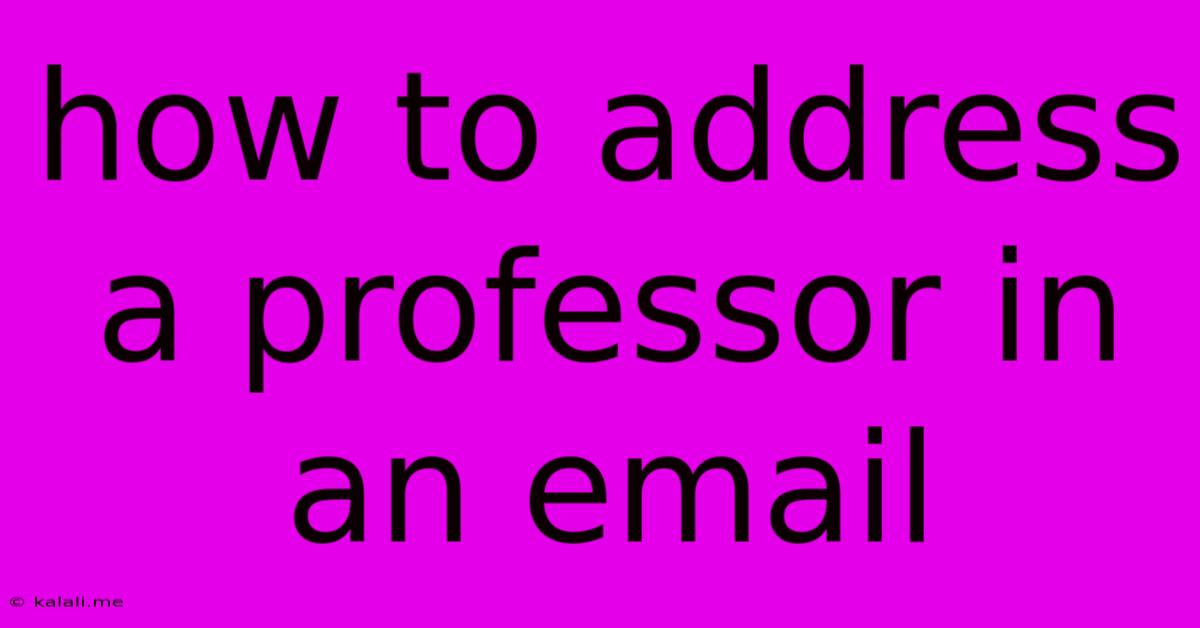How To Address A Professor In An Email
Kalali
May 22, 2025 · 3 min read

Table of Contents
How to Address a Professor in an Email: A Guide to Professional Communication
Knowing how to address a professor in an email is crucial for students, especially in higher education. A well-crafted email shows respect, professionalism, and can significantly impact your interactions with your professors. This guide provides a step-by-step approach to ensure your emails are both effective and courteous. This includes choosing the right salutation, writing a clear and concise message, and using the correct closing. Mastering these skills will enhance your academic experience and build positive relationships with your instructors.
Choosing the Right Salutation
The salutation is the first impression you make. While informality is tempting, maintaining a professional tone is essential. Here's a breakdown of appropriate salutations:
-
If you know the professor's name: Use "Dear Professor [Last Name]," This is the most common and generally accepted approach. Avoid using first names unless explicitly invited to do so.
-
If you don't know the professor's name: Use "Dear Professor [Department]," For example, "Dear Professor, Department of History". This is a perfectly acceptable alternative when a name isn't readily available. You can also check the department website for a faculty roster.
-
What to avoid: Never use informal salutations like "Hey," "Hi," or "Yo." These are inappropriate in academic settings and could be perceived as disrespectful.
Crafting Your Email Body: Clarity and Conciseness
Once you've chosen your salutation, focus on writing a clear, concise, and respectful email body. Remember:
-
State your purpose clearly in the first sentence: Professors are busy, so get straight to the point. Mention the course you're in and the reason for your email. For example, "I am writing to you concerning your History 101 class."
-
Use proper grammar and spelling: Proofread your email carefully before sending it. Errors can undermine your credibility.
-
Maintain a formal tone: Avoid slang, colloquialisms, and overly casual language.
-
Be respectful and polite: Use phrases like "please" and "thank you."
-
Keep it concise: Avoid lengthy paragraphs. Break up your text into shorter, manageable chunks.
-
Use professional closing: A simple "Sincerely," "Regards," or "Respectfully," is appropriate.
Example Email Structure:
Here's an example of a well-structured email to a professor:
Subject: Question Regarding Assignment 3 - History 101
Dear Professor Smith,
I am writing to you concerning your History 101 class. I have a question regarding the upcoming Assignment 3, specifically the section on the French Revolution. [State your specific question clearly and concisely].
Thank you for your time and consideration.
Sincerely,
[Your Name] [Your Student ID Number]
Following Up and Etiquette Considerations
-
Response Time: Allow a reasonable amount of time for a response (2-3 business days). If you haven't heard back after a week, a polite follow-up email is acceptable.
-
Multiple Emails: Avoid sending multiple emails about the same issue unless absolutely necessary.
-
Attachments: If you need to include attachments, ensure they are clearly labeled and relevant.
-
Professional Signature: Include a professional email signature with your name, student ID, and contact information.
By following these guidelines, you can ensure your emails to professors are professional, respectful, and effective. Remember, clear communication is key to a successful academic experience.
Latest Posts
Latest Posts
-
Uk Visit Visa 3 Months Bank Statement
May 22, 2025
-
Washing Machine Smells Damp Even After Cleaning
May 22, 2025
-
How To Say Be Nice In Spanish
May 22, 2025
-
Firex Smoke Alarm Keeps Going Off
May 22, 2025
-
Can Induction Pots Be Used On Gas
May 22, 2025
Related Post
Thank you for visiting our website which covers about How To Address A Professor In An Email . We hope the information provided has been useful to you. Feel free to contact us if you have any questions or need further assistance. See you next time and don't miss to bookmark.